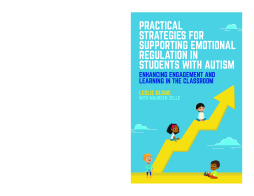
BOOK
Practical Strategies for Supporting Emotional Regulation in Students with Autism
(2018)
Additional Information
Book Details
Abstract
For professionals who work with students on the autism spectrum in inclusive classroom settings, supporting emotional regulation is key. This practical guide outlines cognitive and language strategies that support emotional regulation, which the authors have found successful with their students with autism, supported by research that shows why they work.
The focus in this book is on the emotional state of the child as opposed to controlling behaviours. The guidelines and strategies provided help students with prediction and make the expectations of them clear, empowering children by giving them choices. Examples of how to use each strategy are given, alongside tips for application. The book also includes sample goals for regulation, information on therapy techniques that work and a 'cheat sheet' overview of the strategies, creating a clear and concise guide to engaging and enhancing learning in the classroom.
An informative and practical guide for educators, clinicians, and parents of children who struggle with self-regulation and attention to tasks. The authors clearly have thought critically about what works best for their students, and strive to implement strategies that optimize opportunities for learning, social engagement, and independence.
Hilary Bissell, MS CCC-SLP, Speech-Language Pathologist
Leslie Blome is Speech-Language Pathologist and Maureen Zelle is Early Childhood Special Education Teacher at an inclusive preschool classroom working with children on the autism spectrum with significant needs.
Provides organized, straightforward strategies on how to support significantly impacted kids on the spectrum within a typical preschool classroom. It's a book that my team goes back to again and again!"
Catherine Schuh, MS OTR, Occupational Therapist
Whether you are new to the field, a few years in, or an experienced educator, Leslie Blome and Maureen Zelle will inspire you to elevate your ability to engage students on the Autism Spectrum. They have truly captured the "what," "why," and "how" in a practical recipe for success for exceptional learners in the early childhood classroom.
Christine Trumpour, MEd, Early Childhood Special Educator
Table of Contents
| Section Title | Page | Action | Price |
|---|---|---|---|
| Practical Strategies for Supporting Emotional Regulation in Students with Autism: Enhancing Engagement and Learning in the Classroom \nby Leslie Blome with Maureen Zelle | 3 | ||
| Acknowledgements | 7 | ||
| Introduction | 9 | ||
| 1. Three Guidelines | 23 | ||
| 2. Sensory Overview | 33 | ||
| Show and Tell | 35 | ||
| 3. Modeling | 37 | ||
| 4. Show How Many/Show How Long | 43 | ||
| 5. Verbalize a Rule | 51 | ||
| Moving On | 55 | ||
| 6. First/Then | 57 | ||
| 7. Offer a Choice | 63 | ||
| 8. I Start/You Finish | 69 | ||
| Helping Hands | 73 | ||
| 9. Simple Tasks | 75 | ||
| 10. Incentive Charts | 83 | ||
| 11. Visual schedules | 91 | ||
| One More Thing | 103 | ||
| 12. Techniques | 105 | ||
| Appendix A: Strategies at a Glance | 111 | ||
| Appendix B: Techniques at a Glance | 112 | ||
| Appendix C: Sample Goals | 114 | ||
| Appendix D: Sample Situations | 116 | ||
| References | 122 | ||
| Index | 125 | ||
| Blank Page |
